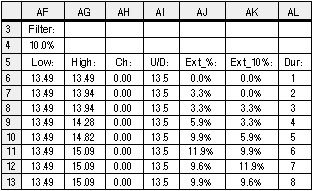EXTENDEDNESSIf the market is more than 75% extended since its last 10% correction, then expect a negative 12-month return (dividends ignored) and a 60% probability of a market decline.
I began by collecting the monthly closes for the S&P 500 from 1950 to 1995. Then I applied a 10% filter and calculated the percentage the market exceeded or fell below the last low or high point of each swing. I treated this percentage value, which I call extendedness, as an indicator, computing it via the following formulas. (Although the filter is based on a simple concept, it requires several spreadsheet columns and formulas to quantify and integrate it into a system. There may be a more compact way of doing this, but creating a few extra columns can pay off in terms of readability and ease of modification.)

First, I entered the monthly S&P 500 closing prices (intramonth highs and lows were ignored, but given the size of the filter, the results are hardly affected) into a spreadsheet. See Figure 1 for a printout of this spreadsheet (S&P 500 data, in column C, are not shown).
INTEREST RATES?
INFLATION? GROWTH?
"Of course, all things are never equal; extendedness says nothing about interest rates, inflation or growth prospects, or the overall health of the economy -- only that in the past, on average, when the market has been this high it has declined over the next year. To be a bull in an extended market requires making a strong case as to why it will be different this time."